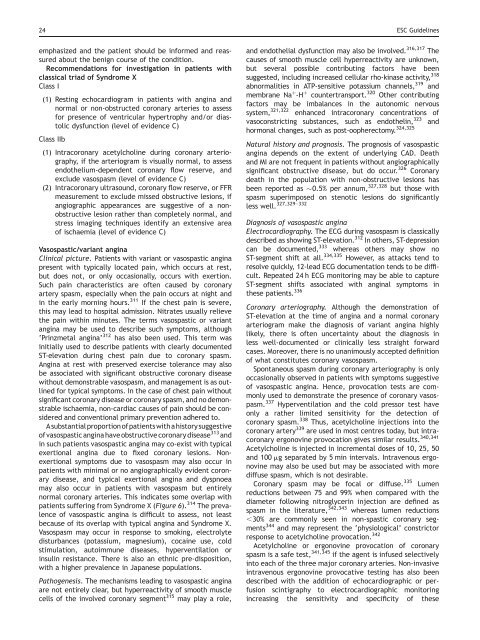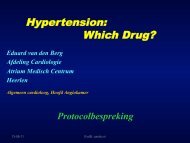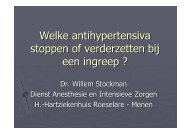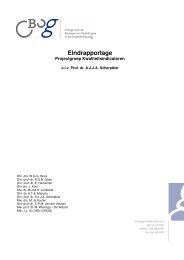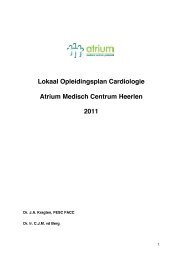Guidelines on the Management of Stable Angina Pectoris ... - Cardio
Guidelines on the Management of Stable Angina Pectoris ... - Cardio
Guidelines on the Management of Stable Angina Pectoris ... - Cardio
Create successful ePaper yourself
Turn your PDF publications into a flip-book with our unique Google optimized e-Paper software.
24 ESC <str<strong>on</strong>g>Guidelines</str<strong>on</strong>g>emphasized and <strong>the</strong> patient should be informed and reassuredabout <strong>the</strong> benign course <strong>of</strong> <strong>the</strong> c<strong>on</strong>diti<strong>on</strong>.Recommendati<strong>on</strong>s for investigati<strong>on</strong> in patients withclassical triad <strong>of</strong> Syndrome XClass I(1) Resting echocardiogram in patients with angina andnormal or n<strong>on</strong>-obstructed cor<strong>on</strong>ary arteries to assessfor presence <strong>of</strong> ventricular hypertrophy and/or diastolicdysfuncti<strong>on</strong> (level <strong>of</strong> evidence C)Class IIb(1) Intracor<strong>on</strong>ary acetylcholine during cor<strong>on</strong>ary arteriography,if <strong>the</strong> arteriogram is visually normal, to assessendo<strong>the</strong>lium-dependent cor<strong>on</strong>ary flow reserve, andexclude vasospasm (level <strong>of</strong> evidence C)(2) Intracor<strong>on</strong>ary ultrasound, cor<strong>on</strong>ary flow reserve, or FFRmeasurement to exclude missed obstructive lesi<strong>on</strong>s, ifangiographic appearances are suggestive <strong>of</strong> a n<strong>on</strong>obstructivelesi<strong>on</strong> ra<strong>the</strong>r than completely normal, andstress imaging techniques identify an extensive area<strong>of</strong> ischaemia (level <strong>of</strong> evidence C)Vasospastic/variant anginaClinical picture. Patients with variant or vasospastic anginapresent with typically located pain, which occurs at rest,but does not, or <strong>on</strong>ly occasi<strong>on</strong>ally, occurs with exerti<strong>on</strong>.Such pain characteristics are <strong>of</strong>ten caused by cor<strong>on</strong>aryartery spasm, especially when <strong>the</strong> pain occurs at night andin <strong>the</strong> early morning hours. 311 If <strong>the</strong> chest pain is severe,this may lead to hospital admissi<strong>on</strong>. Nitrates usually relieve<strong>the</strong> pain within minutes. The terms vasospastic or variantangina may be used to describe such symptoms, although‘Prinzmetal angina’ 312 has also been used. This term wasinitially used to describe patients with clearly documentedST-elevati<strong>on</strong> during chest pain due to cor<strong>on</strong>ary spasm.<strong>Angina</strong> at rest with preserved exercise tolerance may alsobe associated with significant obstructive cor<strong>on</strong>ary diseasewithout dem<strong>on</strong>strable vasospasm, and management is as outlinedfor typical symptoms. In <strong>the</strong> case <strong>of</strong> chest pain withoutsignificant cor<strong>on</strong>ary disease or cor<strong>on</strong>ary spasm, and no dem<strong>on</strong>strableischaemia, n<strong>on</strong>-cardiac causes <strong>of</strong> pain should be c<strong>on</strong>sideredand c<strong>on</strong>venti<strong>on</strong>al primary preventi<strong>on</strong> adhered to.Asubstantialproporti<strong>on</strong> <strong>of</strong>patients withahistorysuggestive<strong>of</strong> vasospastic angina have obstructive cor<strong>on</strong>ary disease 313 andin such patients vasospastic angina may co-exist with typicalexerti<strong>on</strong>al angina due to fixed cor<strong>on</strong>ary lesi<strong>on</strong>s. N<strong>on</strong>exerti<strong>on</strong>alsymptoms due to vasospasm may also occur inpatients with minimal or no angiographically evident cor<strong>on</strong>arydisease, and typical exerti<strong>on</strong>al angina and dyspnoeamay also occur in patients with vasospasm but entirelynormal cor<strong>on</strong>ary arteries. This indicates some overlap withpatients suffering from Syndrome X (Figure 6). 314 The prevalence<strong>of</strong> vasospastic angina is difficult to assess, not leastbecause <strong>of</strong> its overlap with typical angina and Syndrome X.Vasospasm may occur in resp<strong>on</strong>se to smoking, electrolytedisturbances (potassium, magnesium), cocaine use, coldstimulati<strong>on</strong>, autoimmune diseases, hyperventilati<strong>on</strong> orinsulin resistance. There is also an ethnic pre-dispositi<strong>on</strong>,with a higher prevalence in Japanese populati<strong>on</strong>s.Pathogenesis. The mechanisms leading to vasospastic anginaare not entirely clear, but hyperreactivity <strong>of</strong> smooth musclecells <strong>of</strong> <strong>the</strong> involved cor<strong>on</strong>ary segment 315 mayplayarole,and endo<strong>the</strong>lial dysfuncti<strong>on</strong> may also be involved. 316,317 Thecauses <strong>of</strong> smooth muscle cell hyperreactivity are unknown,but several possible c<strong>on</strong>tributing factors have beensuggested, including increased cellular rho-kinase activity, 318abnormalities in ATP-sensitive potassium channels, 319 andmembrane Na þ -H þ countertransport. 320 O<strong>the</strong>r c<strong>on</strong>tributingfactors may be imbalances in <strong>the</strong> aut<strong>on</strong>omic nervoussystem, 321,322 enhanced intracor<strong>on</strong>ary c<strong>on</strong>centrati<strong>on</strong>s <strong>of</strong>vasoc<strong>on</strong>stricting substances, such as endo<strong>the</strong>lin, 323 andhorm<strong>on</strong>al changes, such as post-oopherectomy. 324,325Natural history and prognosis. The prognosis <strong>of</strong> vasospasticangina depends <strong>on</strong> <strong>the</strong> extent <strong>of</strong> underlying CAD. Deathand MI are not frequent in patients without angiographicallysignificant obstructive disease, but do occur. 326 Cor<strong>on</strong>arydeath in <strong>the</strong> populati<strong>on</strong> with n<strong>on</strong>-obstructive lesi<strong>on</strong>s hasbeen reported as 0.5% per annum, 327,328 but those withspasm superimposed <strong>on</strong> stenotic lesi<strong>on</strong>s do significantlyless well. 327,329–332Diagnosis <strong>of</strong> vasospastic anginaElectrocardiography. The ECG during vasospasm is classicallydescribed as showing ST-elevati<strong>on</strong>. 312 In o<strong>the</strong>rs, ST-depressi<strong>on</strong>can be documented, 333 whereas o<strong>the</strong>rs may show noST-segment shift at all. 334,335 However, as attacks tend toresolve quickly, 12-lead ECG documentati<strong>on</strong> tends to be difficult.Repeated 24 h ECG m<strong>on</strong>itoring may be able to captureST-segment shifts associated with anginal symptoms in<strong>the</strong>se patients. 336Cor<strong>on</strong>ary arteriography. Although <strong>the</strong> dem<strong>on</strong>strati<strong>on</strong> <strong>of</strong>ST-elevati<strong>on</strong> at <strong>the</strong> time <strong>of</strong> angina and a normal cor<strong>on</strong>aryarteriogram make <strong>the</strong> diagnosis <strong>of</strong> variant angina highlylikely, <strong>the</strong>re is <strong>of</strong>ten uncertainty about <strong>the</strong> diagnosis inless well-documented or clinically less straight forwardcases. Moreover, <strong>the</strong>re is no unanimously accepted definiti<strong>on</strong><strong>of</strong> what c<strong>on</strong>stitutes cor<strong>on</strong>ary vasospasm.Sp<strong>on</strong>taneous spasm during cor<strong>on</strong>ary arteriography is <strong>on</strong>lyoccasi<strong>on</strong>ally observed in patients with symptoms suggestive<strong>of</strong> vasospastic angina. Hence, provocati<strong>on</strong> tests are comm<strong>on</strong>lyused to dem<strong>on</strong>strate <strong>the</strong> presence <strong>of</strong> cor<strong>on</strong>ary vasospasm.337 Hyperventilati<strong>on</strong> and <strong>the</strong> cold pressor test have<strong>on</strong>ly a ra<strong>the</strong>r limited sensitivity for <strong>the</strong> detecti<strong>on</strong> <strong>of</strong>cor<strong>on</strong>ary spasm. 338 Thus, acetylcholine injecti<strong>on</strong>s into <strong>the</strong>cor<strong>on</strong>ary artery 339 are used in most centres today, but intracor<strong>on</strong>aryerg<strong>on</strong>ovine provocati<strong>on</strong> gives similar results. 340,341Acetylcholine is injected in incremental doses <strong>of</strong> 10, 25, 50and 100 mg separated by 5 min intervals. Intravenous erg<strong>on</strong>ovinemay also be used but may be associated with morediffuse spasm, which is not desirable.Cor<strong>on</strong>ary spasm may be focal or diffuse. 335 Lumenreducti<strong>on</strong>s between 75 and 99% when compared with <strong>the</strong>diameter following nitroglycerin injecti<strong>on</strong> are defined asspasm in <strong>the</strong> literature, 342,343 whereas lumen reducti<strong>on</strong>s,30% are comm<strong>on</strong>ly seen in n<strong>on</strong>-spastic cor<strong>on</strong>ary segments344 and may represent <strong>the</strong> ‘physiological’ c<strong>on</strong>strictorresp<strong>on</strong>se to acetylcholine provocati<strong>on</strong>. 342Acetylcholine or erg<strong>on</strong>ovine provocati<strong>on</strong> <strong>of</strong> cor<strong>on</strong>aryspasm is a safe test, 341,345 if <strong>the</strong> agent is infused selectivelyinto each <strong>of</strong> <strong>the</strong> three major cor<strong>on</strong>ary arteries. N<strong>on</strong>-invasiveintravenous erg<strong>on</strong>ovine provocative testing has also beendescribed with <strong>the</strong> additi<strong>on</strong> <strong>of</strong> echocardiographic or perfusi<strong>on</strong>scintigraphy to electrocardiographic m<strong>on</strong>itoringincreasing <strong>the</strong> sensitivity and specificity <strong>of</strong> <strong>the</strong>se


